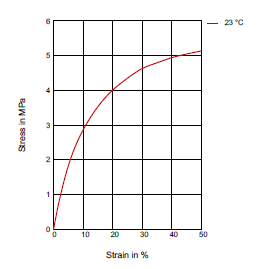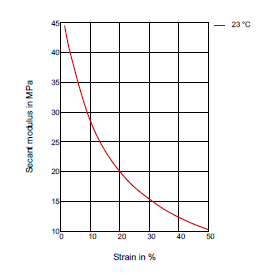Enhanced TDS
Identification & Functionality
- Additives Included
- Blend
- Yes
- Chemical Family
- Polymer Name
- Product Code
- MITM15139
- Single Ingredient
- No
- Technologies
- Product Families
Features & Benefits
- Labeling Claims
- Materials Features
Applications & Uses
- Plastics & Elastomers End Uses
- Plastics & Elastomers Processing Methods
- Markets
- Applications
- Processing Information
Injection Molding, Film Extrusion, Profile Extrusion, Other Extrusion, Transfer Molding, Casting, Thermoforming.
Properties
- Physical Form
Technical Details & Test Data
- Technical Data
Stress-Strain Diagram:

Secant Modulus-Strain Diagram:

Processing conditions (injection molding):
- Typical melt temperature (Min / Recommended / Max): 180°C / 210°C / 260°C.
- Typical mold temperature: 10 ~ 30°C.
- Drying time and temperature (only necessary for bags opened for more than two hours): 4-8 hours at 55-65°C.
Processing conditions (extrusion):
- Typical melt temperature (Min / Recommended / Max): 190°C / 205°C / 220°C.
- Drying time and temperature (only necessary for bags opened for more than two hours): 4-8 hours at 55-65°C.
Packaging & Availability
- Packaging Type
- Product Packaging
PEBAX® Rnew® 35R53 SP 01 is delivered dried in sealed packaging (25 kg bags) ready to be processed.
Other
- Carbon Content
- 29.0 %
- Color (SDS)
- Colorless to slightly yellow
- Decomposition Temperature (SDS)
- 536.0 °F
- Density
- 1020.0 kg/m³
- Density
- 1020.0 kg/m³
- Hardness
- 25.0 Shore D
- Hardness
- 25.0 Shore A
- Humidity Absorption
- 0.5 %
- Item Number
- Lower Explosion Limit (SDS)
- 29.0 %
- Melting Point
- 135.0 °C
- Mold Shrinkage
- 0.6 %
- Mold Shrinkage
- 0.6 %
- Mold Shrinkage
- 0.6 %
- Mold Shrinkage
- 0.6 %
- Odor (SDS)
- Odorless
- Other Hazards
- Processing may release vapors and/or fumes which cause eye, skin and respiratory tract irritation., Prolonged or repeated exposure may cause: headache, drowsiness, nausea, weakness. (severity of effects depends on extent of exposure).
- Principal
- Shelf Life
- 2.0 yr
- Softening Point
- 81.0 °C
- Strain at Break
- min. 300.0 %
- Strain at Break
- min. 50.0 %
- Stress
- 5.0 MPa
- Stress at Break
- 30.0 MPa
- Tensile Modulus
- 40.0 MPa
- Water Absorption
- 1.3 %
- Shelf Life & Stability
Value Units Test Method / Conditions Shelf Life 2.0 yr yr - Mechanical Properties
Value Units Test Method / Conditions Hardness 25.0 Shore D Shore D Hardness 25.0 Shore A Shore A ISO 868 Strain at Break min. 300.0 % % ISO 527-1 at break thermoplastic elastomer, dry Strain at Break min. 50.0 % % ISO 527-2 at break, condensed Stress 5.0 MPa MPa ISO 527-2 at 50% strain, condensed Stress at Break 30.0 MPa MPa ISO 527-1 at break thermoplastic elastomer, dry Tensile Modulus 40.0 MPa MPa ISO 527-2 condensed - Physical Properties
Value Units Test Method / Conditions Density 1020.0 kg/m³ kg/m³ ISO 1183 condensed Density 1020.0 kg/m³ kg/m³ ISO 1183 Dry Humidity Absorption 0.5 % % ISO 62 Dry Melting Point 135.0 °C °C ISO 11357-1 at 10°C/min Mold Shrinkage 0.6 % % ISO 2577 normal, dry Mold Shrinkage 0.6 % % ISO 2577 parallel, dry Mold Shrinkage 0.6 % % ISO 294-4 normal, dry Mold Shrinkage 0.6 % % ISO 294-4 parallel, dry Softening Point 81.0 °C °C ISO 306 at 50°C/h, 50N, dry Water Absorption 1.3 % % ISO 62 Dry - Material Composition
Value Units Test Method / Conditions Carbon Content 29.0 % % ASTM D6866 - SDS Physical and Chemical Properties
Value Units Test Method / Conditions Decomposition Temperature (SDS) 536.0 °F °F Lower Explosion Limit (SDS) 29.0 % % at 85⁰C
